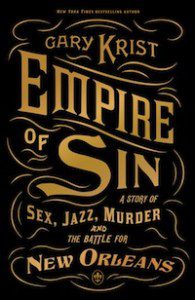
My friend recently pointed out a tiny New Orleans restaurant and said the mob (allegedly) ran the shop across the street as a front. No way, I thought. The restaurant looked kitschy. Pink neon lights framed the door, and decrepit statues greeted customers. I decided that no sinister activities could take place near such a delightful establishment.
But a few days later I started reading Gary Krist’s Empire of Sin: A Story of Sex, Jazz, Murder, and the Battle for Modern New Orleans, which focuses on the city’s attempts at “respectability” from 1890 to 1920. Now I’m re-thinking my friend’s allegation.
At the start of the eighteenth century, New Orleans was established as a French outpost. Later, Spain controlled the city, and in a clandestine treaty handed the territory back to France, which sold New Orleans to the United States in 1803. The New Orleans of the late nineteenth century wasn’t very concerned with morality, because, as Krist writes, its “lax cosmopolitan ethos hardly conformed to American norms of behavior.” During the thirty years that Krist covers, the city came to be defined by vice: prostitution, gambling, and other “sinful” acts. It was “The Sodom of the South.”
Krist pays special attention to how organized crime, including the group known as The Black Hand, affected the city’s evolution. He couches his narrative in an examination of the Axman murders – one of the most gruesome, unsolved crime sprees in the nation’s history. The Axman, allegedly affiliated with a crime organization, would sneak into houses and violently attack victims, with—yes—an ax. These crimes wounded NOLA’s psyche and led to a very popular piece of music known as “The Mysterious Axman’s Jazz (Don’t Scare Me Papa).”
Aside from the heinous murders and the odds of being robbed, a life of vice may sound like fun. But the city’s more “respectable” citizens weren’t having it. In the late nineteenth century, city officials decided to contain all the vice within an already dangerous 18-block area, because they believed, as Krist writes, “it would do the least harm to decent sensibilities.” In 1898, the district—behind the Vieux Carre, downriver of Canal Street—opened for business. The area eventually became known as Storyville (there’s a funny story to the name…) and within its borders – but nowhere else in the city – prostitution was legal. A similar but much smaller area uptown of Canal Street would later become known as Black Storyville, which Krist compellingly explores when he dissects the era’s escalating racial tension.

Empire of Sin is one of those rare works that is both well-written and well-researched. The prose is easy to follow—quite a feat considering how much ground Krists covers. He balances city politics, serial killers, and murder. He gives us a tour of Storyville by focusing on the biographies of some its key players. My two favorite: brothel madam Josie Lobrano – who later had a few different aliases as she tried to clean up her act – and Tom “Mayor of Storyville” Anderson. These citizens of the demimonde dance. On the page, they’re still alive, drinking whisky and shooting at people who have slighted them. Krist makes us root for these brothel owners and law-breakers. They may have been all kinds of wild, but they were still just trying to make a decent living.
Krist’s direct approach to the subject matter is most useful when he’s writing about the history of jazz, a musical style created by black musicians such as Buddy Bolden and Sidney Bechet. Because of the city’s European heritage, New Orleans didn’t initially hold the same views on race as the rest of the American South. In the NOLA of 1870, Krist writes, black citizens could vote and serve on juries. But with “reform,” and an attempt to draw money from the North, the city began to adopt a stance on segregation similar to the rest of its neighboring states. While New Orleans now celebrates jazz – often called the “first truly American art form” – the city didn’t exactly welcome its emergence in the early twentieth century. Reformers loved to reform, and many of the upper class (read: wealthy white people) considered jazz to be a raunchy, sexy-time music that should be banned. Krist often, humorously, uses archived newspaper editorials to contextualize the “respectable” citizens’ take on the music. He notes that back in 1918 the city’s Times-Picayune published the now-infamous editorial “Jass and Jassism,” which described the music as a “loud and meaningless sound.”
Black musicians pioneered jazz, but the form’s first musical recordings came from a white band in a New York studio. For a while, the music’s bad-boy reputation helped contribute the soundtrack of New Orleans’s pimps and prostitutes. Black musicians were allowed to work in Storyville, but they couldn’t patronize the main brothels. “Storyville’s reputation as the birthplace of jazz,” he writes, “has often been exaggerated – Black Storyville across Canal Street actually has a better claim – but the District can definitely take credit for nurturing the new music’s childhood adolescence.” Police often raided venues where jazzmen played. Famous trumpeter Louis Armstrong, who now has a huge park named after him in the city, even left his birthplace of New Orleans for Chicago so he could get away from the menacing racial conditions. Krist interweaves these narratives to contextualize the growing tensions. The suspense and intrigue mount, even as he deconstructs socially constructed ideas of morality.
New Orleans still may not be the safest (or most “respectable”) place in the country. But as Krist’s book deftly shows, “respectability” didn’t necessarily benefit everyone in New Orleans. Without spit-shining the grimy parts, Empire of Sin celebrates the city’s history. This book shows why the Crescent City has always been one of the most vibrant places in the country.




